The AMD Radeon R9 Fury X Review: Aiming For the Top
by Ryan Smith on July 2, 2015 11:15 AM ESTGrand Theft Auto V
The final game in our review of the R9 Fury X is our most recent addition, Grand Theft Auto V. The latest edition of Rockstar’s venerable series of open world action games, Grand Theft Auto V was originally released to the last-gen consoles back in 2013. However thanks to a rather significant facelift for the current-gen consoles and PCs, along with the ability to greatly turn up rendering distances and add other features like MSAA and more realistic shadows, the end result is a game that is still among the most stressful of our benchmarks when all of its features are turned up. Furthermore, in a move rather uncharacteristic of most open world action games, Grand Theft Auto also includes a very comprehensive benchmark mode, giving us a great chance to look into the performance of an open world action game.
On a quick note about settings, as Grand Theft Auto V doesn't have pre-defined settings tiers, I want to quickly note what settings we're using. For "Very High" quality we have all of the primary graphics settings turned up to their highest setting, with the exception of grass, which is at its own very high setting. Meanwhile 4x MSAA is enabled for direct views and reflections. This setting also involves turning on some of the advanced redering features - the game's long shadows, high resolution shadows, and high definition flight streaming - but it not increasing the view distance any further.
Otherwise for "High" quality we take the same basic settings but turn off all MSAA, which significantly reduces the GPU rendering and VRAM requirements.
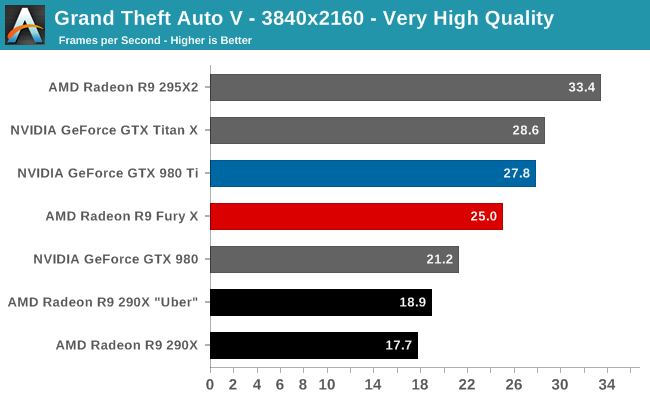
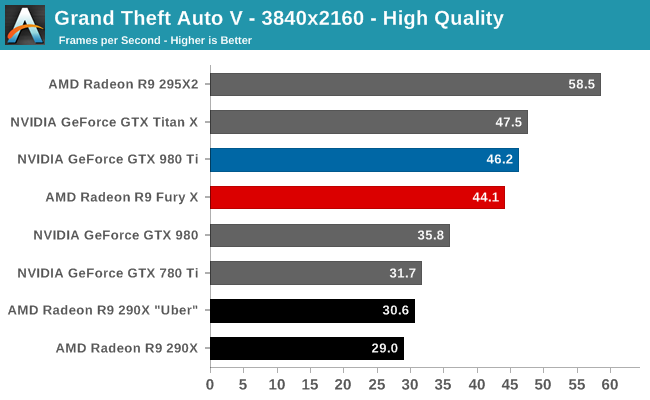
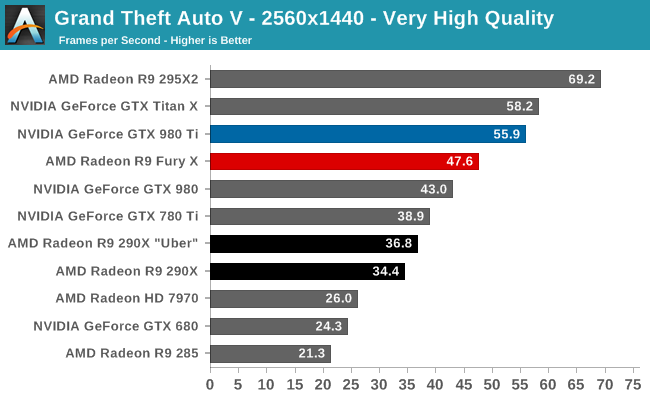
Our final game sees the R9 Fury X go out on either an average or slightly worse than average note, depending on the settings and resolution we are looking at. At our highest 4K settings the R9 Fury X trails the GTX 980 Ti once again, this time by 10%. Worse, at 1440p it’s now 15%. On the other hand if we run at our lower, more playable 4K settings, then the gap is only 5%, roughly in line with the overall average 4K performance gap between the GTX 980 Ti and R9 Fury X.
In this case it’s probably to AMD’s benefit that our highest 4K settings aren’t actually playable on a single GPU card, as the necessary drop in quality gets them closer to NVIDIA’s performance. On the other hand this does reiterate the fact that right now many games will force a tradeoff between resolution and quality if you wish to pursue 4K gaming.
Finally, the performance gains relative to the R9 290X are pretty good. 29% at 1440p, and 44% at the lower quality playable 4K resolution setting.
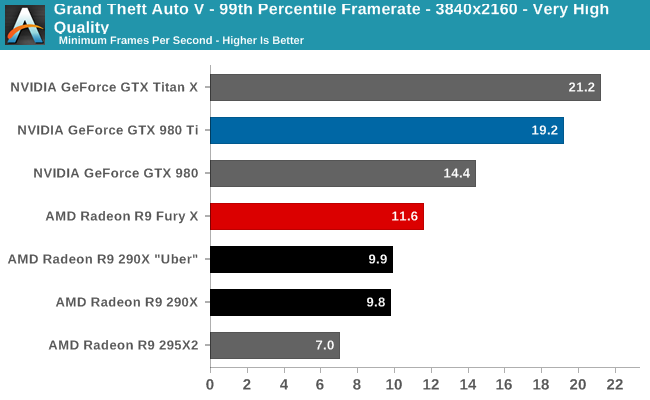
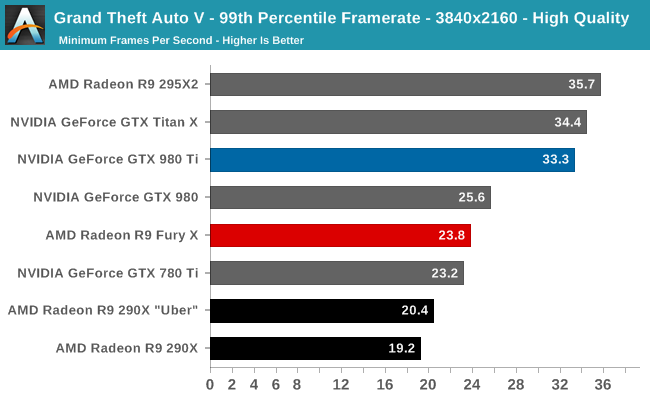
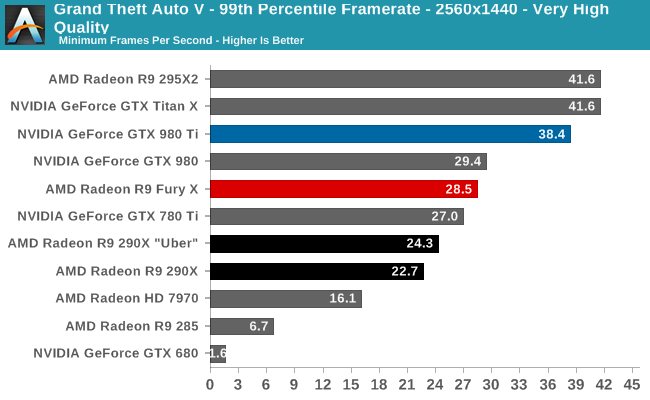
Shifting gears to 99th percentile frametimes however – a much-welcome feature of the game’s built-in benchmark – finds that AMD doesn’t fare nearly as well. At the 99th percentile the R9 Fury X trails the GTX 980 Ti at all times, and significantly so. The deficit is anywhere between 26% at 1440p to 40% at 4K Very High.
What’s happening here is a combination of multiple factors. First and foremost, next to Shadow of Mordor, GTAV is our other VRAM busting game. This, I believe, is why 99th percentile performance dives so hard at 4K Very High for the R9 Fury X, as it only has 4GB of VRAM compared to 6GB on the GTX 980 Ti. But considering where the GTX 980 places – above the R9 Fury X – I also believe there’s more than just VRAM bottlenecking occurring here. The GTX 980 sees at least marginally better framerates with the same size VRAM pool (and a lot less of almost everything else), which leads me to believe that AMD’s drivers may be holding them back here. Certainly the R9 290X comparison lends some possible credit to that, as the 99th percentile gains are under 20%. Regardless, one wouldn’t expect to be VRAM limited at 1440p or 4K without MSAA, especially as this test was not originally designed to bust 4GB cards.










458 Comments
View All Comments
chizow - Thursday, July 2, 2015 - link
What about geometry Ryan? ROPs are often used interchangeably with Geometry/Set-up engine, there is definitely something going on with Fury X at lower resolutions, in instances where SP performance is no problem, it just can't draw/fill pixels fast enough and performs VERY similarly to previous gen or weaker cards (290X/390X and 980). TechReport actually has quite a few theoreticals that show this, where their pixel fill is way behind GM200 and much closer to Hawaii/GM204.extide - Thursday, July 2, 2015 - link
Yeah my bet is on Geometry. Check out the Synthetics page. It own the Pixel and Texel fillrate tests, but loses on the Tessellation test which has a large dependency on geometry. nVidia has also been historically very strong with geometry.CajunArson - Thursday, July 2, 2015 - link
Thanks for the review! While the conclusions aren't really any different than all the other reputable review sites on the Interwebs, you were very thorough and brought an interesting perspective to the table too. Better late than never!NikosD - Thursday, July 2, 2015 - link
You must use the latest nightly build of LAV filters, in order to be able to use the 4K H.264 DXVA decoder of AMD cards.All previous builds fall back to SW mode.
tynopik - Thursday, July 2, 2015 - link
"today’s launch of the Fiji GPU"andychow - Thursday, July 2, 2015 - link
Best review ever. Worth the wait. Get sick more often!tynopik - Thursday, July 2, 2015 - link
pg 2 - compression taking palcelimitedaccess - Thursday, July 2, 2015 - link
Ryan, regarding Mantle performance back in the R9 285 review (http://www.anandtech.com/show/8460/amd-radeon-r9-2... you wrote that AMD stated the issue with performance regression was that developers had not yet optimized for Tonga's newer architecture. While here you state that the performance regression is due to AMD having not optimized on the driver side. What is the actual case? What is the actual weighting given these three categories? -Hardware Driver
API
Software/Game
What I'm wondering is if we make an assumption that upcoming low level APIs will have similar behavior as Mantle what will happen going forward as more GPU architectures are introduced and newer games are introduced? If the onus shifts especially heavily towards the software side it it seems more realistic in practice that developers will have much more narrower scope in which optimize for.
I'm wondering if Anandtech could possibly look more indept into this issue as to how it pertains to the move towards low level APIs used in the future as it could have large implications in terms of the software/hardware support relationship going forward.
Ryan Smith - Thursday, July 2, 2015 - link
"What is the actual case? What is the actual weighting given these three categories? -"Right now the ball appears to be solidly in AMD's court. They are taking responsibility for the poor performance of certain Mantle titles on R9 Fury X.
As it stands I hesitate to read into this too much for DX12/Vulkan. Those are going to be finalized, widely supported APIs, unlike Mantle which has gone from production to retirement in the span of just over a year.
limitedaccess - Thursday, July 2, 2015 - link
Thanks for the response. I guess we will see more for certain as time moves on.My concern is if lower level APIs require more architecture specific optimizations and the burden is shifted to developers in practice that will cause some rather "interesting" implications.
Also what would be of interest is how much of reviewers test suites will still look at DX11 performance as a possible fallback should this become a possible issue.